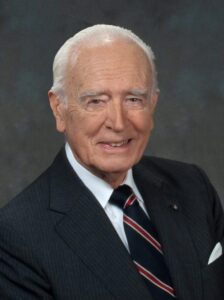
Title: Architect (Retired)
Location: Sarasota, Florida, United States
William Graff, Architect, has been recognized by Marquis Who’s Who Top Executives for dedication, achievements, and leadership in architecture.
With more than four decades of architectural practice, William Pancsovai Graff has been recognized as an outstanding practitioner in that profession. Born in Budapest, Hungary, to Vilmos Pancsovai Graff II and Klara Pejtsik in 1925, Mr. Graff’s career spanned many countries. Educated in his early years in Italy, he grew up among some of the most famous structures of the world. Back in Hungary, he obtained his Master of Architecture at the Budapest Technical University, one of the four such institutions in Europe at that time.
Due to political considerations, Mr. Graff escaped from Hungary in 1949, and worked in Rome until his emigration to Canada in 1951. Once there, he worked at Marani and Morris and John B. Parkin in Toronto on both the Crown Life and the Confederation Life buildings.
In 1954, he was fortunate to gain entry into the United States, working first with Maguolo and Quick in Baltimore, Maryland. In 1956, he joined Hugh Stubbins and Associates in Cambridge, Massachusetts, where he participated in the design of Boston’s first condominium at 330 Beacon St., as well as plans for the Berlin Kongress Halle, a gift in 1956 from the United States to that beleaguered city.
When Walter Gropius’ The Architects Collaborative was awarded the design of the Baghdad University by King Feisal of Iraq, Mr. Graff moved as one of its members to Rome in 1960 to participate in this challenging 11,000-student project, which included housing not only for the students but also for the faculty and all their families, with religious, medical and educational accommodations. During the 2002 Iraqi war, the campus incredibly was not damaged.
In 1962, Mr. Graff joined the Società Generale Immobiliare in Rome to lead the Studio Gábor Ács, which was entrusted with several international projects, the most important of these being The Watergate Project in Washington, D.C., whose primary designer was Luigi Moretti of Rome. Other major projects were the Tour de La Bourse with Pier Luigi Nervi and the Port Royal residencies in Montreal, the Hotel Mirabeau in Monte Carlo and the 82 Champs d’Elysées in Paris. Then in 1964, Mr. Graff was selected as the project architect for The Watergate and moved back to the United States with his family.
By 1967, Mr. Graff and Henry C. Holle formed the Holle and Graff Partnership. Several large condominium projects for IDI in the Capital City area followed, starting with the Watergate at Landmark, the Rotonda, the Montebello, the Porto Vecchio and the Belvedere, as well as office buildings, such as the International Club at 1800 and the office complex at 1801 K St. NW, and the Wink and Westin City Center Hotels. Following these projects, the partnership designed the twin office buildings at 8200 Greensboro Drive, McLean, Virginia, for IDI, the Bush Hill and Hoffman Office Centers in Alexandria, Virginia, as well as the One Central Plaza on Rockville Pike, the National Central Research, the Plaza 270 and the headquarters of the National Cash Register Co. buildings in Rockville, Maryland. Before leaving Holle and Graff, his partnership developed the area’s first Leisure World in Aspen Hill, Maryland.
In 1982, Mr. Graff joined Ralph Parsons for the planning of Yanbu City on the Red Sea, during which time he was also entrusted with the design of an island vacation palace for the Saudi Royal Family.
The invitation by the United States Department of State, Foreign Buildings Office, arrived in 1983, to participate in the intergovernmental negotiations concerning 15 real estate properties in Budapest, some of which had been expropriated after 1945 by the government of Hungary. Mr. Graff wished to express his gratitude and to honor both his native and adoptive countries by accepting this unique and very challenging assignment.
Ambassador Nicolas M. Salgo, of conglomerate fame, led the talks for almost two years, assisted by Mr. Graff’s professional and language skills. Part of the successful settlement was the building of an American International School in the Buda Hills, the renovation of all American diplomatic residences and the construction of additional housing for the growing American diplomatic staff.
His most exciting personal project was the design of the first two solar houses in Washington, D.C., one being his own residence on Arizona Terrace NW.
Since 1972, Mr. Graff was a member of the Hungarian Association of the Sovereign Military Order of Malta. He joined the American Institute of Architects in 1967, and was registered with NCARB and in several states. Due to his outstanding achievements, he was honored in numerous editions of Who’s Who in America. His partnership also received awards from builders’ groups since the condominium projects were bestsellers throughout the United States.
In 1959, the year he became an American citizen, Mr. Graff married Clara Lenke Marot, daughter of the formerly Hungarian General Staff Major Béla N. Marót and his wife, Lenke Legendai Radwány, in Stamford, Connecticut. They went on to become the proud parents of four children: Marcella, Carlo, Guido and Mattias, as well as six grandchildren: Chiara, Fabiola, Fiona, Lily, William and Henry. Mr. Graff died in 2019, after a long and fulfilling life.
For more information, please visit:
Contact Mr. Graff:



